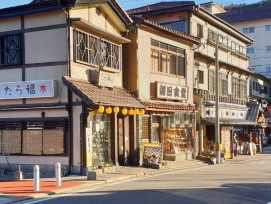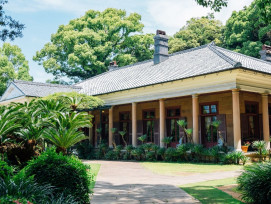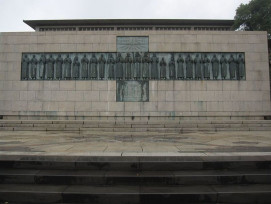
This city is known to many as one of the two cities in Japan that was bombed during the Second World War. It's not surprising that today, like Hiroshima, Nagasaki is now home to many attractions linked to this difficult period in the history of the country. The first bomb was dropped on Hiroshima and the second on Nagasaki. Like Hiroshima, you can visit museums and monuments that tell the story of the survivors and those who lost their lives here but there is so much more to this vibrant city today than doom and gloom. From historic relics to architecture from when there was a strong Dutch presence in the city. There is so much to see and do here and incredible hidden gems waiting to be discovered.

Museum of Tropical Medicine
Museum of Tropical Medicine
Definitely one of the more unusual things to do in Nagasaki. At this museum, you can come within inches of preserved Ebola-spreading bats and all sorts of jars full of formaldehyde. These jars contain a wide range of specimens such as strains of tropical diseases, parasites, bacteria, viruses, poisonous insects, and dangerous animals. It’s a very informative museum that aims to use its collection to strengthen public health science and risk communication. The Museum of Tropical Medicine was founded in March 1942, to perform basic and applied studies on endemic tropical diseases in East Asia, and has since grown into the leading research center for tropical medicine in Japan. Entrance to the museum is free and it’s a great place to explore, just maybe not before lunch.

Photo credit: commons.wikimedia.org/wiki/File:Fukusai-j
Fukusai-ji Temple
This temple takes the form of a huge turtle carrying an 18m-high figure of the goddess Kannon on its back and it’s an incredible sight to see. Inside the temple, you’ll find a Foucault pendulum that demonstrates the rotation of the earth of its axis. The Foucault pendulum hangs down from near the top of the hollow statue and is similar to the larger versions in St Petersburg and Paris. Sadly the original temple built in 1628, which was of Chinese origin, was completely destroyed during the bombing. The replacement was built in 1976. The temple bell rings at 11.02 daily, the exact time of the bomb's explosion.

Ōura Church
Ōura Church
Considered the oldest standing Christian church in Japan, the Ōura Church was built towards the end of the Edo Period in 1864 by a French missionary for the growing community of foreign merchants in the city. The church is dedicated to the memory of the 26 Christians who were executed in the city in 1597 and today, the working church stands as an attractive example of contemporary European architecture. The church was the first Western-style building in Japan to be designated as a national treasure and is an unusual sight among the traditional Japanese buildings.

Glover House and Office
Glover House and Office
You’ll find the Glover House and Office nestled in the lush Glover Gardens. The house and office are said to have inspired Puccini's "Madame Butterfly." Scottish merchant Thomas Blake Glover built the house in the 1860s. You’ll notice a blend of traditional Japanese architectural elements with a Georgian-style exterior. The structure's latticed arches, stone-floored verandas, French windows, and British chimneys mounted on a Japanese roof covered with tiles is quite a sight to see. While you are exploring the park, look for the statues of Puccini and Miura Tamaki, who played Madame Butterfly.

Photo credit: commons.wikimedia.org/wiki/File:Medical_M
Atomic Bomb Medical Museum
During the postwar decades, the Nagasaki University School of Medicine established the Atomic Disease Institute. It became a center for the collection of relevant scientific specimens, general information on hibakusha (the Japanese word for survivors of the atomic bomb attacks), medical records, scientific literature, personal reports, and memorabilia. You’ll be able to get a brief but comprehensive introduction to the effects of nuclear weapons and shows the devastating impact of the atomic bomb on the human body. The aim is to advocate for a world free of weapons of mass destruction and ensure that Nagasaki is the last place on earth to endure the catastrophes that follow in the wake of a nuclear explosion.

Photo credit: blog.nationalgeographic.org/2015/10/08/na
Head of the Virgin Mary
The atomic bomb landed 1,640 feet away from the Urakami Cathedral in Nagasaki. As you can expect, the building was almost completely destroyed, however the bust of the Virgin Mary survived. Though the building was almost completely destroyed, some remnants of the church still exist. The cathedral was rebuilt near where its predecessor had once stood and today parts of the original building are preserved in the Nagasaki Peace Park. The salvaged head of the Virgin Mary is one of the few religious relics that survived. It rests in a special chapel within the cathedral. Once a year, on the anniversary of the bombing the bust is brought outside the cathedral for a peaceful memorial procession.

Photo credit: commons.wikimedia.org/wiki/File:Suwa_Shri
Suwa Shrine
The origins of this ancient Suwa Shrine can be traced back to the 1500s. Originally located at present-day teramachi-dori (Temple Street). The Suwa Shrine, together with other Buddhist and Shinto relics, was destroyed by the Christians. In an effort to revive the Shinto faith, Suwa Shrine was rebuilt in 1625 and relocated to its present location in 1648. Each October the Nagasaki Kunchi Festival takes place here. It has a history dating back to almost 400 years and is one of the largest festivals in Japan.

Gunkanjima Island
Gunkanjima Island
This small island is located about 20 kilometers from Nagasaki Port. Until 1974, the island served as a coal mine, and more than 5000 residents called the 480 meters long, 150-meter wide island home. The island was once home to the highest population density in history recorded worldwide. To accommodate so many people in such a small area, every piece of land was built up so the island came to resemble a massive battleship. In fact, "Gunkanjima" is a nickname that means "battleship island" in Japanese. The island's formal name is Hashima. In April 1974, the mine was closed, and its residents had to leave Gunkanjima, abandoning the island with all its buildings. Today you can tour the dilapidated island and see it up close for yourself.

Photo credit: https://commons.wikimedia.org/wiki/File_S
Twenty-Six Martyrs Museum
This museum is dedicated to the twenty-six Christians who were executed here on February 5, 1597. They included both foreign missionaries and Japanese laymen. Missionary activities were prohibited at the time, and Japan's ruler Toyotomi Hideyoshi staged the execution as a warning. The monument is located in a small park on a hill not far from Nagasaki Station and offers nice views over the city. The museum behind the monument is devoted to the memory of the martyrs and to Christianity in Japan in general. The interior is reminiscent of a church with stained-glass windows. You’ll find artifacts related to Christianity in Japan, including old documents, statues, and jewelry. It’s a great place to visit if you’re looking for something different to do in Nagasaki.

Mt. Inasa
Mt. Inasa
A must-visit when you’re in Nagasaki, this is where you can gaze at a truly beautiful nighttime view. The view is so beautiful that it’s nicknamed the “10-million dollar night view.” To get to the summit that is 333m above sea level, you’ll need to ride in a ropeway gondola that is run by Nagasaki Ropeway (round-trip fare is 1,230 JPY for adults). The ride itself is breathtaking and when you reach the summit you’ll be able to marvel at the magnificent twinkling night scene below. The observation deck is the perfect place for a date night with the romantic atmosphere created by the play of lights that seem to magically rise from below.
